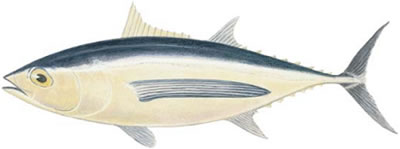A member of the Scombridae family of tuna and mackerel, the albacore is an excellent light-tackle gamefish. It is called true albacore in some places, not to be confused with false albacore or little tunny.
Identification
The albacore has long pectoral fins that reach to a point beyond the anal fin, as well as small finlets on both the back and the belly that extend from the anal fin to the tail. The albacore is colored dark blue, shading to greenish-blue near the tail, and is silvery white on the belly. A metallic or iridescent cast covers the entire body. The dorsal finlets are yellowish, except for the white trailing edge of the tail, and the anal finlets are silvery or dusky.Size
The average weight for albacore is between 10 and 25 pounds. The all-tackle record is 88 pounds, 2 ounces, although commercially caught fish have weighed as much as 93 pounds. The albacore can grow to 5 feet in length. |
 |
Life history/Behavior
A schooling fish, the albacore is migratory and pelagic; that is, it lives and feeds in the open sea. It roams widely, varying in location from within a few miles of shore to far offshore, as currents and water temperatures dictate. Its availability can change widely from year to year. Albacore have been described as one of the world’s fastest migrant fish, and tagging studies have tracked them across entire oceans.Albacore spawn from July through October along the west coast of North America and in the summer season in the Southern Hemisphere of the mid-Pacific.
Food and feeding habits
The albacore diet consists of fish, squid, and crustaceans. Albacore feed in schools, which sometimes consist of other tuna-family members, and these schools are typically found around floating objects such as sargassum. Although they will feed at middle depths, they ordinarily feed close to the surface.Other Names
longfin tuna, long-finned tunny, longfin, true albacore, albacore tuna, albie, and pigfish; French: germon; Hawaiian: áhi pahala; Japanese: binchô, binnaga; Portuguese: albacora; Spanish: albacora, atún blanco.Distribution
Albacore are found worldwide in tropical and temperate seas, including the Mediterranean, but they also make seasonal migrations into colder zones such as New England, southern Brazil, and the northern Gulf of Mexico.In the western Atlantic, albacore range from Nova Scotia to Brazil, although they rarely range north of New York and are absent from the Straits of Florida; in the Pacific Ocean, they range from Alaska to Mexico. Albacore are abundant in the Pacific but less common in the Atlantic.
